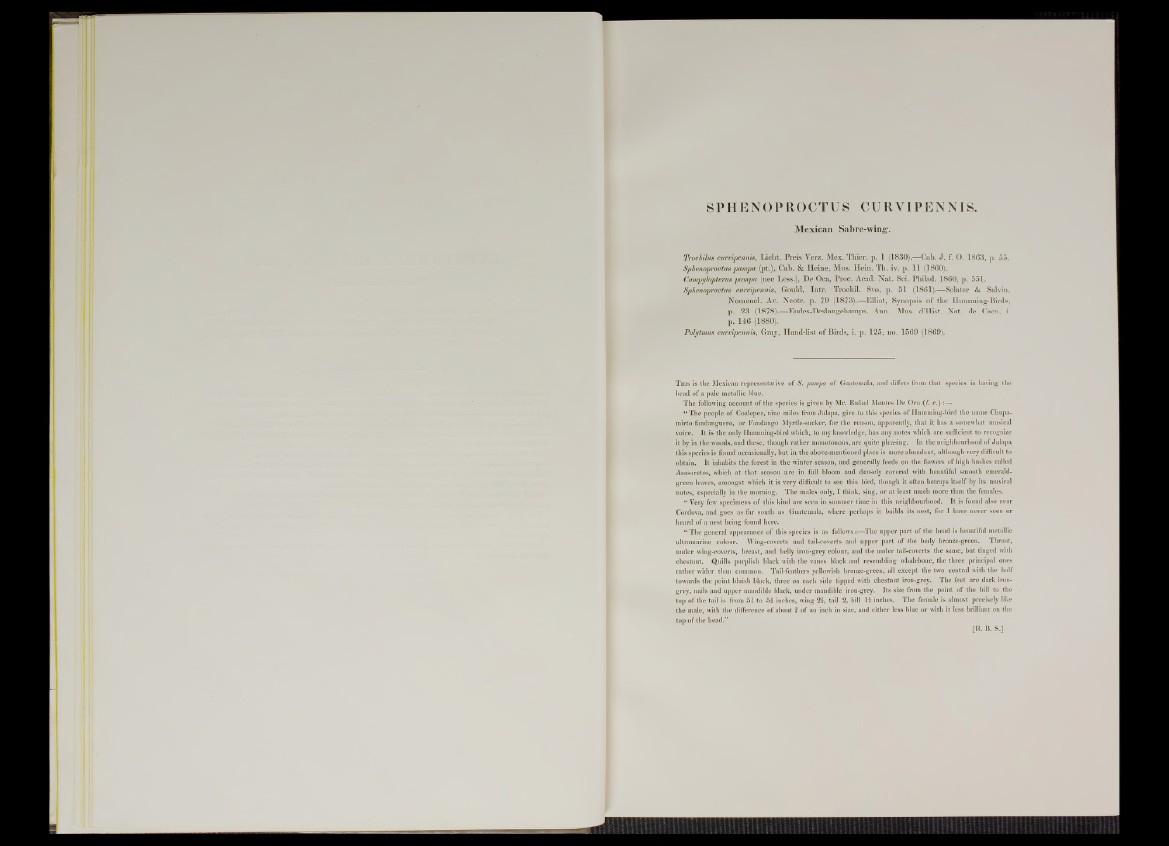
SPHENOPROCTUS CURV1PENNIS.
Mexican Sabre-wing*.
Trochilus curvipennis, Licht. Preis Verz. Mex. Thier, p. 1 (1830).— Cab. J. f. 0 . 1 8 6 3 , p. 55.
Sphenoproctus p am p a (pt.), Cab. & H eine, Mus. Hein. Th. iv. p. 11 (1860).
Campylopterus p am p a (nee Less*), D e Oca, Proc. Acad. N a t. Sei. Philad. 1860, p. 551.
Sphenoproctus curvipennis, Gould, Intr. Trochil. 8vo, p. 51 (1861).— Sclater & Salvin,
Nom en c l. Av. Neotr. p. 7 9 (1873).— Elliot, Synopsis o f the Humming-Birds,
p. 2 3 (1878).— Eudes-Deslongchamps, Ann. Mus. d’Hist. Nat. de Caen, i.
p. 1 4 6 (1880).
Polytmus cui'vipennis, Gray, Hand-list o f B irds, i. p. 1 25, no. 1 5 6 9 (1869).
T h i s is th e Mexican re p re se n ta tiv e o f S. pampa o f Gua temala, and differs from th a t species in having the
head o f a p a le metallic blue.
The following account of the species is given by Mr. Rafael Montes De Oca (/. c.)
“ The people of Coalepec, nine miles from Jalapa, give to this species of Humming-bird the name Chupamirto
fandanguero, or Fandango Myrtle-sucker, for the reason, apparently, that it has a somewhat musical
voice. It is the only Humming-bird which, to my knowledge, has any notes which are sufficient to recognize
it by in the woods, and these, though rather monotonous, are quite pleasing. In the neighbourhood of Jalapa
this species is found occasionally, but in the above-mentioned place is more abundant, although very difficult to
obtain. It inhabits the forest in the winter season, and generally feeds on the flowers of high bushes called
Asasaretos, which at that seasou are in full bloom and densely covered with beautiful smooth emerald-
green leaves, amongst which it is very difficult to see this bird, though it often betrays itself by its musical
notes, especially in the morning. The males only, I think, sing, or at least much more than the females.
“ Very few specimens of this kind are seen in summer time in this neighbourhood. It is found also near
Cordova, and goes as far south as Guatemala, where perhaps it builds its nest, for I have never seen or
heard of a nest being found bere.
“ The general appearance of this species is as follows:—The upper part of the head is beautiful metallic
ultramarine colour. Wing-coverts and tail-coverts and upper part of the body bronze-green. Throat,
under wing-coverts, breast, and belly iron-grey colour, and the under tail-coverts the same, but tinged with
chestnut. Quills purplish black with the vanes black and resembling whalebone, the three principal ones
rather wider than common. Tail-feathers yellowish bronze-green, all except the two central with the half
towards the point bluish black, three on each side tipped with chestnut iron-grey. The feet are dark iron-
grey, nails and upper mandible black, under mandible iron-grey. Its size from the point of the bill to the
top of the tail is from 5 i to 51 inches, wing 2f, tail 2, bill l i inches. The female is almost precisely like
the male, with the difference o f about # o f an inch in size, and either less blue or with it less brilliant on the
top of the head.”
[R. B. S.]